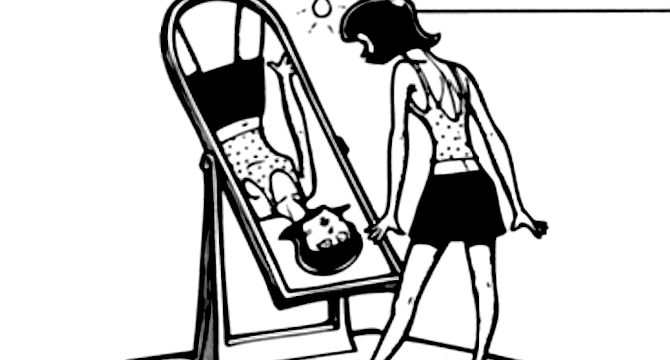 Facebook
Facebook
 X
X
 Instagram
Instagram
 TikTok
TikTok
 Youtube
Youtube

Dear Matthew Alice: This sounds like a dumb question until somebody tries to explain it and finds out it isn’t so simple. Why do we perceive an image in a mirror as reversed horizontally, but not inverted vertically? — Charles L. Williams, Carlsbad
Dang, Mr. Williams, I’ll try my best to make this complicated, but I’m not sure I can. Light waves travel in a straight line. I could stop right there, since that’s the explanation, but let’s press on. Say you’re facing a mirror and wearing a porkpie hat, big floppy clown shoes, with an orchid corsage on your left wrist, and you’re writing a bad novel with a pen in your right hand. Then you have a friend tie a string to each of these features and pull each string straight ahead (as the light waves travel) and tape it down where it meets the mirror. The hat string is stuck to the top of the mirror, the shoe string to the bottom, the corsage on the left side, and the pen on the right. But if you imagine that man in the mirror to be some darned handsome stranger looking back at you through a window, you see that he looks remarkably familiar, but he’s left-handed. The left-to-right reversal actually takes place in your mind, not in the mirror. Mirror man is not standing on his head because there’s nothing to bend the light waves toward each other and reverse top and bottom.
The convex lenses of our eyes, though, do bend light waves so they converge and actually create a completely reversed and inverted image on our retinas. But our brains unscramble that picture to turn the world right side up again. So on your retina at least, mirror man’s image is right-handed.
People who spend hours in front of the mirror would likely be horrified to know that dazzling reflection is not what the rest of the world sees. No face (or body, for that matter) is perfectly vertically symmetrical. Maybe one eye’s bigger or higher up, or your nose or lip is lopsided. In the mirror you see yourself with that left-right swap, but everybody else sees your direct image. To see what they see, try looking at your mug in a mirror that is reflecting another mirror image. It’s a whole new you. Is that confusing enough? Hope so.


Dear Matthew Alice: This sounds like a dumb question until somebody tries to explain it and finds out it isn’t so simple. Why do we perceive an image in a mirror as reversed horizontally, but not inverted vertically? — Charles L. Williams, Carlsbad
Dang, Mr. Williams, I’ll try my best to make this complicated, but I’m not sure I can. Light waves travel in a straight line. I could stop right there, since that’s the explanation, but let’s press on. Say you’re facing a mirror and wearing a porkpie hat, big floppy clown shoes, with an orchid corsage on your left wrist, and you’re writing a bad novel with a pen in your right hand. Then you have a friend tie a string to each of these features and pull each string straight ahead (as the light waves travel) and tape it down where it meets the mirror. The hat string is stuck to the top of the mirror, the shoe string to the bottom, the corsage on the left side, and the pen on the right. But if you imagine that man in the mirror to be some darned handsome stranger looking back at you through a window, you see that he looks remarkably familiar, but he’s left-handed. The left-to-right reversal actually takes place in your mind, not in the mirror. Mirror man is not standing on his head because there’s nothing to bend the light waves toward each other and reverse top and bottom.
The convex lenses of our eyes, though, do bend light waves so they converge and actually create a completely reversed and inverted image on our retinas. But our brains unscramble that picture to turn the world right side up again. So on your retina at least, mirror man’s image is right-handed.
People who spend hours in front of the mirror would likely be horrified to know that dazzling reflection is not what the rest of the world sees. No face (or body, for that matter) is perfectly vertically symmetrical. Maybe one eye’s bigger or higher up, or your nose or lip is lopsided. In the mirror you see yourself with that left-right swap, but everybody else sees your direct image. To see what they see, try looking at your mug in a mirror that is reflecting another mirror image. It’s a whole new you. Is that confusing enough? Hope so.
Comments